Today we see Noss. I am excited all morning. We leave Lerwick on a boat, much smaller than the one we took to Mousa. This is going to be a very different experience. Unlike Mousa we wont get to cover the island on foot. Instead we have opted to see it by sea. Noss is a small island east of Lerwick, a national reserve where over 100,000 pairs of seabirds of various kinds come to nest.
 |
| To Noss... |
To get to Noss we first must sail around the beautiful island of Bressay, much larger than Noss but wearing the same red sandstones of the smaller island to its east. Our hosts are incredibly friendly and enormously knowledgeable in the sea life that abounds here. Am all ears. We keep an eye out for seals. Summer is quiet not here and it is unlikely we would sight any whales I am told. Although the captain says of the one time when an Orca dived under the boat before pulling up along side them . It gives me goose bumps. I think I would cry if I see a whale. Those enormous beautiful creatures of the ocean.
 |
| The sky is the limit... |
Birds swoop ahead. And then we sight our first seals. Basking in the sun. Seals can be stupid sometimes our captain says. They feel most secure in the water. So if we get too close and they feel threatened they would not hesitate to jump into the blue sea. Well that works well if its a ship coming after you. But they do the same if they sight a whale, suicide almost!..
I ask about the difference between the Grey and Common seals, two of the most common seal mammals here. Others include Otters. The common names are rather misleading cause Common seals are Grey and Grey seals are quite common :). What makes the two species can be told apart by the shape of their snout. The common seal has a more rounded snout while the grey seal has a more protruding one...
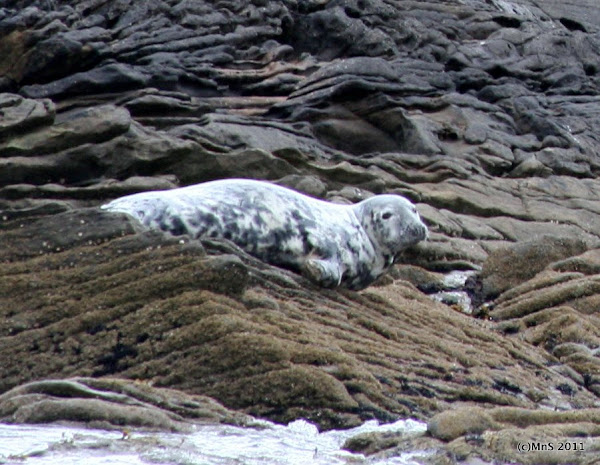 |
| Common seals.. |
The cliffs are beautiful. Dark brown , drenched in the blue waters and reaching up to the skies. The sea can be quiet an artists, sculpting, etching, chipping away and all around we see the most spectacular rock formations. We sail into a cave.
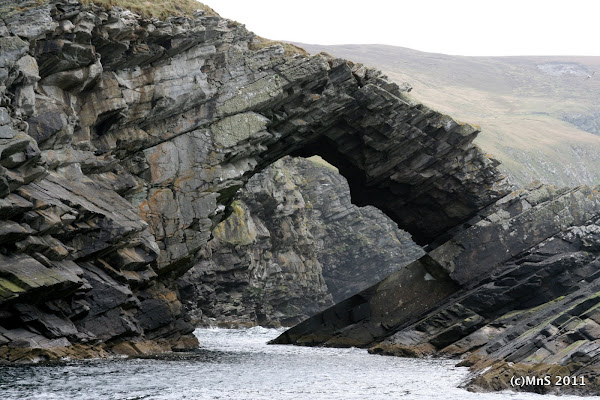 |
| Arch shaped rock formation.. |
I peer into the direction of the captain's pointed finger, a gleaming eye catches my attention. And there in the cover of darkness we see
Shags. They nest here in the cover of darkness. The handout I have from the RSPB says of them ,
Shangs are goose-sized, dark, long-necked birds similar to cormorants but smaller. In the breeding season, adults develop a dark glossy green plumage and prominent crest.
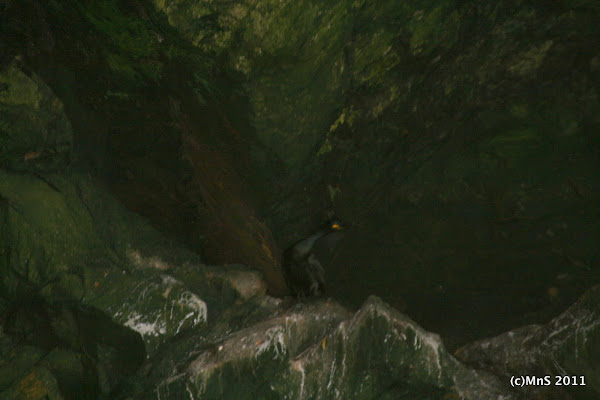 |
| Sailing into a cave.. Shags nest inside the rocks here |
All around we can hear the ocean roar. The waves crash against the cave. We stand here a while and we sail out. The cave is beautiful from a distance.
 |
| Sailing out of it.. |
We sail past another rocky ledge and standing up on them are little birds in pigeon suits. They really do look like miniature penguins.
Guillemots , our hostess says. They nest here in colonies on the cliffs. They are strikingly beautiful. There are couple of species of Guillemots and they can be told apart by certain distinctive features. The black Guillemots have orange feet (How cool is that :)). But the ones we are seeing bespectacled with white rings round the eyes are the common ones. Theirs eggs are pear shaped , to prevent them from rolling off the cliff's edge.
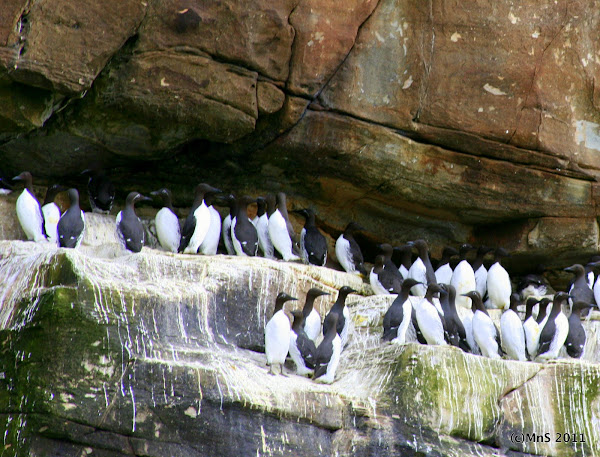 |
| Guillemots.. standing up they look like little penguins |
Its time for some coffee. And as the kettle boils and the smell wafts through the cool sea air, sharp as a knife others get wind and circle ahead. And then we see the top predator here. The great skua circles overhead.
This is a seagull evolving into an eagle, The captain explains. Its a beautiful bird, strong and powerful. Our host holds a biscuit ahead and the skua circles above waiting for the right moment to strike. And then in one swift graceful movement the biscuit is gone. The are known to kill smaller birds like
Puffins and they steal food off others forcing them to give up their prey(
Kleptoparasitism)
 |
| The great skua circling above our boat.. |
I get a few great shots. Others join the party. A beautiful gull swoops low, my lens is in full zoom and I feel like hes gotten too close to comfort and jolt back only to realize hes a little way off :).
 |
| ..Circles again and again.. |
 |
| A Gull swoops low.. |
We see more seals. The sun is out and they seem to be enjoying laying out on their backs. Living the life as they say.
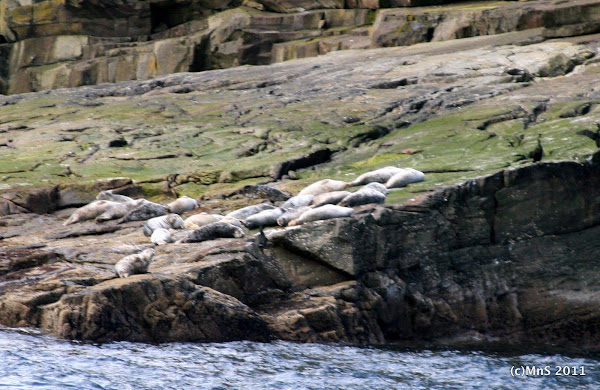 |
| More Seals.. |
We are closing in on Noss. The name of the island comes form the Norse word -
Nose. Unlike Mousa this island is inhabited. Its being used for sheep farming , the perfect grazing ground - The sheep are left free , and they roam as they please , with restrictions being imposed only during lambing. In the 1870's this island was used as a breeding ground for the famous Shetland ponies. The island is dominated by the Skuas who nest inland, laying their eggs on the ground (as we saw in Mousa). Others are relegated to the cliffs.
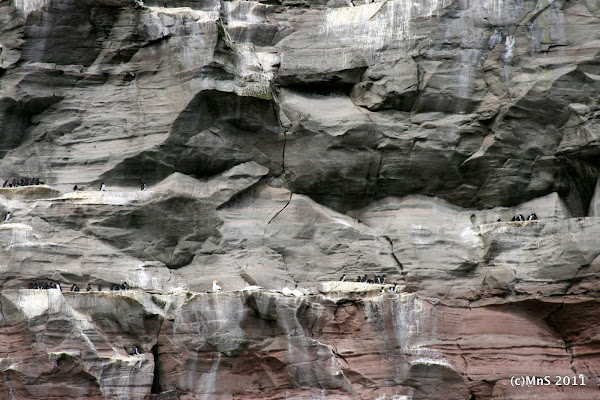 |
| Guillemots ..standing on the rocky ledges.. |
We spy more Guillemots. Seems like a scene out of Jurassic park, with the cliffs looming large and the chorus of a thousand sea birds punctuating the cold air. They seem to effortlessly glide through the air. Truly poetry in motion! The sea and waves have conspired in the perfect way to build this astonishing feat of high rise living. Not even the skyscrapers of Shanghai are a favorable comparison. As with most things there is a hierarchy to the order of things here. Guillemots of which there are close to 45000 nesting pairs occupy the lower ledges.
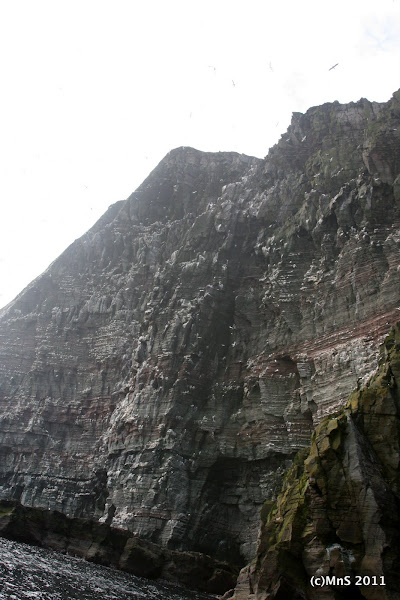 |
| The cliff comes alive with birds... |
The higher cliffs are monopolized by the larger gannets. Their striking white and yellow forms make them easy to discern. They are everywhere. Our hostess explains,
if you are a gannet and you go out to sea its never easy getting back home. How would you tell your mate apart from the rest? ..and so she goes on to explain how gannets read body language of the other to try and make out some order in all this chaos.
 |
| The chorus of a million seabirds chanting.. |
A gannet with its beak raised up towards the sky is telling its mate that it wants to be the one going out to sea. Sometimes a stalemate might ensue , if both partners look skywards. And this would definitely require one of them to be more grounded if some resolution must be reached in the interest of the hungry chick :).
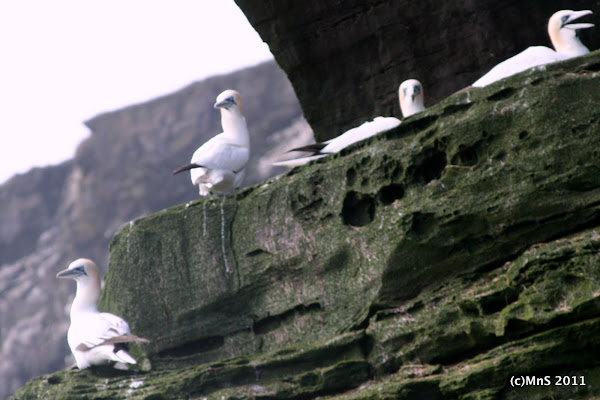 |
| Gannets.. |
 |
| Gannet colonies.. |
The gannet colonies are beautiful. We see them repeatedly plunge into the sea and fly back. It requires a great deal of effort for a gannet to launch itself from the ocean into the air. We come by a bird sitting there , helpless..and out captain explains that this is mostly signs of a Gannets end. If unable to launch itself it eventually dies in the open ocean.
 |
| A gannet surveys the sea .. |
We cant get enough of these beautiful birds. This place is primeval
 |
| Preening those lovely feathers.. |
 |
| Rituals of love.. |
 |
| Gannet colony.. |
 |
| Cliffs of seabirds,, |
After spending some time here , we head back to Lerwick.
 |
| Getting back.. |
Lovely pictures. Looks like I should keep it on my list if I ever go to UK again.
ReplyDelete